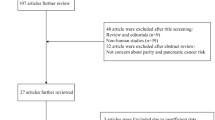Clinical, animal, and epidemiologic evidence indicates that exogenous steroids influence the risk of hepatocellular carcinoma (HCC) and a recent study suggested that parity also may increase the risk of this tumor in women. The latter hypothesis was evaluated in the data from a case-control study which was carried out in Athens and covered 166 male and 19 female cases of HCC, and 381 male and 51 female hospital controls. Among males, there was no association between the number of liveborn children and risk of HCC, whereas among women, there was a suggestive positive association. Compared with women with one or two children, the relative risk for HCC was 0.6 among nulliparous women, 1.3 among those with three or four children and 1.7 among those with five or more children. The association of parity with risk of HCC was limited to women who were positive for hepatitis-B surface antigen (HBsAg) and was not confounded by hepatitis-C virus infection or tobacco smoking. The small number of HCC cases does not permit firm conclusions. If confirmed, however, these results would provide the foundation for a practical preventive advice that could be given to women who are positive for HBsAg.
Similar content being viewed by others
References
Henderson B, Preston-Martin S, Edmonson HA, Peters RL, Pike MC. Hepatocellular carcinoma and oral contraceptives. Br J Cancer 1983; 48: 437–40.
Neuberger J, Forman D, Doll R, Williams R. Oral contraceptives and hepatocellular carcinoma. Br J Cancer 1986; 292: 1355–7.
Forman D, Vincent TJ, Doll R. Cancer of the liver and the use of oral contraceptives. Br J Cancer 1986; 292: 1357–61.
Palmer JL, Rosenberg L, Kaufman DW, Warshauer ME, Stolley P, Shapiro S. Oral contraceptive use and liver cancer. Am J Epidemiol 1989; 130: 878–82.
La Vecchia C, Negri E, Parazzini F. Oral contraceptives and primary liver cancer. Br J Cancer 1989; 59: 460–1.
The WHO Collaborative Study of Neoplasia and Steroid Contraceptives. Combined oral contraceptives and liver cancer. Int J Cancer 1989; 43: 254–9.
Vall Mayans M, Calvet X, Bruix J, et al. Risk factors for hepatocellular carcinoma in Catalonia, Spain. Int J Cancer 1990; 46: 378–81.
Kew MC, Song E, Mohammed A, Hodkinson J. Contraceptive steroids as a risk factor for hepatocellular carcinoma: a case/control study in South African black women. Hepatology 1990; 11: 298–302.
Hsing A, Hoover R, McLaughlin J, et al. Oral contraceptives and primary liver cancer among young women. Cancer Causes Control 1991; 2: 43–8.
Thomas DB. Exogenous steroid hormones and hepatocellular carcinoma. In: Tabor E, Di Bisceglie AM, Purcell RH, eds. Etiology, Pathology, and Treatment of Hepatocellular Carcinoma in North America. Houston, TX: Adv Applied Biotech Series 1991: 13: 77–89.
Stanford J, Thomas D, and the WHO Collaborative Study of Neoplasia and Steroid Contraceptives. Reproductive factors in the etiology of hepatocellular carcinoma. Cancer Causes Control 1991; 2: 37–42.
Trichopoulos D, Tabor E, Gerety RJ, et al. Hepatitis B and primary hepatocellular carcinoma in a European population. Lancet 1978; ii: 1217–9.
Trichopoulos D, Day N, Kaklamani E, et al. Hepatitis B virus, tobacco smoking and ethanol consumption in the etiology of hepatocellular carcinoma. Int J Cancer 1987; 39: 45–9.
Kaklamani E, Trichopoulos D, Tzonou A, et al. Hepatitis B and C viruses and their interaction in the origin of hepatocellular carcinoma. JAMA 1991; 265: 1974–6.
Mantel N. Chi-square test with one degree of freedom: extension of the Mantel-Haenszel procedure. J Am Stat Assoc 1963; 59: 690–700.
Breslow NE, Day NE. Statistical Methods in Cancer Research. Vol. 1. The Analysis of Case-control Studies. Lyon: International Agency for Research on Cancer, 1980; IARC Sci Pub. No. 32.
International Agency for Research on Cancer. Overall Evaluations of Carcinogenicity: An Updating of IARC Monographs 1–42. Lyon, France: IARC, 1987; IARC Monogr Eval Carcinog Risks Humans. Suppl 7: 96–9, 272–309.
Tomatis L, ed. Cancer: Causes, Occurrence and Control. Lyon, France: International Agency for Research on Cancer, 1990; IARC Sci. Pub. No. 100: 59–60, 88–94, 151–4.
Wanless IR, Medline A. Role of estrogens as promoters of hepatic neoplasia. Lab Invest 1982; 46: 313–20.
Proter LE, Van Thiel DH, Eagon PK. Estrogens and progestins as tumor inducers. Sem Liver Dis 1987; 7: 24–31.
Blumberg BS. The hepatitis B virus. Pub Hlth Rep 1980; 95: 427–35.
Kew MC. The possible etiologic role of hepatitis-B virus in hepatocellular carcinoma: evidence from Southern Africa. In: Chisari FV, ed. Advances in Hepatitis Research. New York: Masson, 1984; 203–15.
Yen SSC. Endocrinology of pregnancy. In: Creasy RK, Resnic R, eds. Maternal-Fetal Medicine. Second edn. Philadelphia, PA: WB Saunders, 1989; 375–403.
Miller AB, Barclay THC, Choi NW, et al. A study of cancer, parity and age at first pregnancy. J Chron Dis 1980, 33: 595–605.
Plesko I, Preston-Martin S, Day NE, Tzonou A, Dimitrova E, Somogyi J. Parity and cancer risk in Slovakia. Int J Cancer 1985; 36: 529–33.
Austin H. The role of tobacco use and alcohol consumption in the etiology of hepatocellular carcinoma. In: Tabor E, Di Bisceglie A, Purcell RH, eds. Etiology, Pathology, and Treatment of Hepatocellular Carcinoma in North America. Houston, TX: Adv Applied Biotech Series, 1991; 13: 57–75.
Additional information
Drs Tzonou and Zavitsanos are with the Department of Hygiene and Epidemiology, University of Athens, Medical School, 11527 Athens, Greece. Drs Hsieh and Trichopoulos are with the Department of Epidemiology, Harvard School of Public Health, 677 Huntington Avenue, Boston, MA 02115, USA. Address correspondence to Dr Trichopoulos. This work was supported in Athens by a grant to the University of Athens from the Greek Ministry of Health, and in Boston by a grant to Harvard University from the Leon Lemos Foundation.
Rights and permissions
About this article
Cite this article
Tzonou, A., Zavitsanos, X., Hsieh, Cc. et al. Liveborn children and risk of hepatocellular carcinoma. Cancer Causes Control 3, 171–174 (1992). https://doi.org/10.1007/BF00051657
Received:
Accepted:
Issue Date:
DOI: https://doi.org/10.1007/BF00051657




